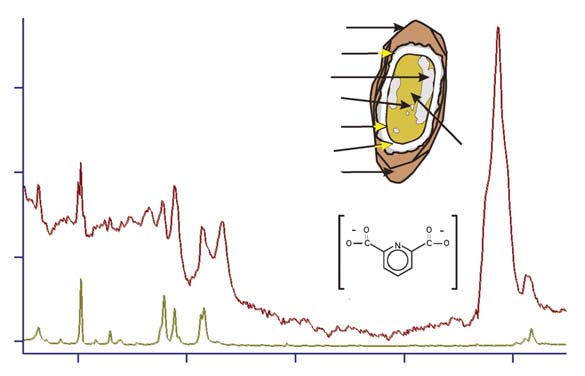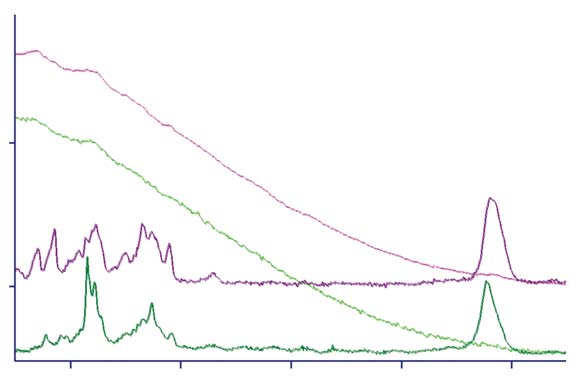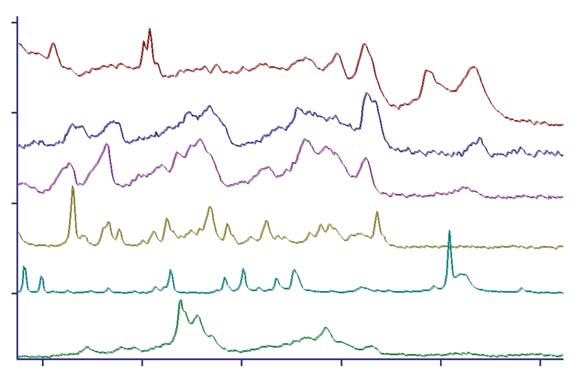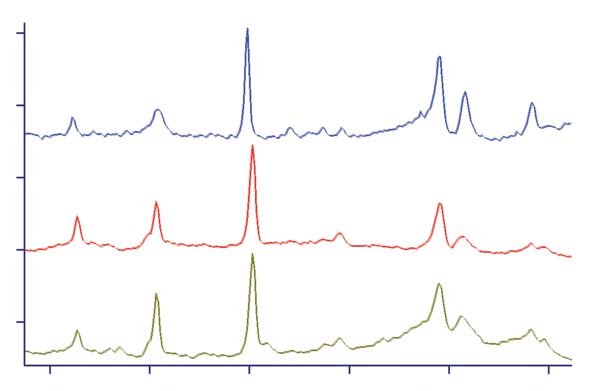Detecting bacillus spores by raman and surface-enhanced raman spectroscopy (sers)

Detecting Bacillus Spores by Raman
and Surface-Enhanced Raman
Spectroscopy (SERS)
Raman spectroscopy has been employed to detect Bacillus cereus
spores, an anthrax surrogate, collected from a letter as it passed
Intensity (arbitrary units)
through a mail sorting system. Raman spectroscopy also has the
capability to identify many common substances used as hoaxes. A
Calcium dipicolinate
three-step method also is decribed for the detection of dipicolinic
acid extracted from surface spores by SERS.
Stuart Farquharson, Wayne Smith, Carl Brouillette, and Frank Inscore
Figure 1. Raman spectra of (a) Bacillus cereus spores and (b) calcium dipicolinate.
mmediately following the September
other bacteria and from each other (1,2).
Conditions: 500 mW of 1064 nm at the sample, 5-min acquisition time.
11, 2001 terrorist attacks, four letters
From this bioterrorist attack, it became
Icontaining anthrax causing spores clear that considerably faster methods of
were mailed through the U.S. postal sys-
analysis were required. This would expe-
in the form of hoax letters (5–7). Literally
very small samples can be measured with-
tem infecting 22 individuals, five fatally.
dite assessment of the scale of an attack as
tens of thousands of letters containing
out preparation. The sample need only be
The anxiety caused by this bioterrorist
well as the extent of facility contamina-
harmless powders have been mailed to
placed at the focal spot of the excitation
attack was exacerbated by the extensive
tion. This information, in turn, could be
create additional fear (8). Consequently,
laser and measured. Moreover, the rich
time required for positive identification
used to minimize fatalities, because it was
an analyzer must not only be able to dif-
molecular information provided by
of the Bacillus anthracis spores and the
learned that if exposure is detected with-
ferentiate B. anthracis spores from other
Raman spectroscopy usually allows
unknown extent of their distribution
in the first few days, the majority of vic-
biological materials, but must be able also
unequivocal identification of chemicals
along the east coast. The delay in identi-
tims can be treated successfully using
to identify these harmless powders to
and biochemicals. As early as 1974, the
fication was due to the fact that spores
ciprofloxacin, doxycycline, and penicillin
eliminate fear and potentially costly Raman spectrum of Bacillus megaterium
had to be germinated and grown in cul-
G procaine (3). However, the challenges
shutdowns (9).
was measured and shown to be domi-
ture media to sufficient cell numbers so
of developing such an analyzer are formi-
In the case of postal-targeted terror-
nated by calcium dipicolinate (CaDPA,
that the 16S rRNA gene unique to B.
dable considering that the CDC estimates
ism, we have been investigating the
14). This chemical can be used as a signa-
anthracis could be measured. Conse-
that inhalation of 10,000 anthracis
utility of Raman and surface-enhanced
ture since only spore forming bacteria
quently, the Center for Disease Control
endospores or 100 nanograms will be
Raman spectroscopy (SERS) to meet
contain CaDPA, at 10% by weight
and Prevention (CDC) employed a com-
lethal to 50% of an exposed population
the analytical challenges of speed, sen-
(15–17), and the most common spores,
bination of biological analyses of culture
(4). An additional challenge has emerged
sitivity, and selectivity by identifying
such as pollen and mold spores, do not.
grown colonies and polymerase chain
since the 2001 attacks, in that a secondary
visible and invisible particles on sur-
The ability of Raman spectroscopy to
reactions to differentiate bacilli from
type of postal-terrorism has proliferated
faces, respectively (10–13).
measure and identify spores is exempli-fied in Figure 1. Here an 1-mm3 spec
Stuart Farquharson is president and CEO, Wayne Smith is vice-president of
Raman Spectroscopy — Bacilli
( 100 mg) of Bacillus cereus spores, a
Raman products, Carl Brouillette is a senior instrument design engineer, and
Spores and Hoax Materials
nontoxic surrogate for B. anthracis spores,
Frank Inscore is a senior Raman applications specialist, all with Real-Time Analyzers,
Raman spectroscopy is attractive because
was placed on a glass surface, positioned
Inc. (East Hartford, CT). E-mail: [email protected].

at the focal point of a 1064-nm excitation
cm-1 is composed of overlapping, non-
laser, and measured in 5 min using an FT-
specific organic CH2 and CH3 stretching
Raman spectrometer. Comparison of this
modes. The relative intensities of the
spectrum to that for CaDPA shows that
protein bands can be further used to dif-
the characteristic peaks of the latter at 821,
ferentiate between bacilli using chemo-
1014, 1391, 1446, 1573, and 3080 cm-1 are
metric approaches (20 ).
observed readily in the former. These
The same FT-Raman spectrometer
peaks can be assigned to a CH out-of-
was used to measure and differentiate
plane bend, the symmetric pyridine ring
some 100 common powders as potential
stretch, an OCO symmetric stretch, a
hoax materials (11). During these meas-
symmetric ring CH bend, an asymmetric
urements, it was found that many com-
OCO stretch, and the aromatic CH asym-
mon powders, such as coffee creamer and
metric stretch, respectively.
household cleaners, fluoresce at visible
The B. cereus spore spectrum also
laser excitation wavelengths, even at 785
contains peaks at 1003, 1241, and 1666
nm. This was true also for both white and
cm-1 that are characteristic of proteins.
brown envelope paper that is found com-
Specifically, these peaks correspond to
monly as debris on sorting machines.
the phenylalanine ring breathing mode,
Fortunately, obscuration of the Raman
and the amide III and amide I stretching
spectrum by fluorescent emission can be
modes of peptide linkages, respectively
avoided using 1064 nm laser excitation,
(18,19). The most intense peak at 2935
and high quality spectra can be obtained
Intensity (arbitrary units)
Figure 2. Raman spectra of (a) and (c) flour and (b) and (d) brown envelope paper.
Conditions: (a) and (b) 785 nm, (c) and (d) 1064 nm, all 500 mW, 5-min acquisition
time.

stants, particle size, and irradiation wave-
allowed to dry to mimic a contaminated
length must be satisfied to generate the
surface. A 100-µL drop of 50 mM DDA
plasmon field. Furthermore, the amount
in ethanol heated to 78 °C was added to
of interaction between the metal plas-
the surface. After 1 min, approximately
mon field and molecule will influence the
10 µL of the solution was drawn into a 1-
amount of enhancement.
mm diameter glass capillary containing a
For the present application, it has been
1-cm plug of silver-doped sol-gel. The
shown that dipicolinic acid (DPA), the
SER spectrum of DPA collected in the
acid form of CaDPA, produces an intense
SER-active capillary was then measured
SER spectrum when it interacts with the
using a Raman spectrometer. Figure 4c
Intensity (arbitrary units)
plasmon field of silver nanoparticles
shows a representative spectrum from
(Figure 4), and it is, therefore, suitable as a
one of these capillaries using 150 mW of
signature for bacilli spores (12,13). The
785 nm laser excitation and a 1-min
SER spectrum of 1 mg/L DPA in water is
acquisition time. The primary DPA
similar in intensity to the Raman spec-
peaks at 657 cm-1, 812 cm-1, 1006 cm-1,
trum of a saturated solution of DPA (80
1381 cm-1, and 1426 cm-1 are observed
g/L DPA in 1 N KOH). Taking into
readily. The DPA signal intensity is simi-
account sample concentration, laser
lar to the 1-mg/L sample obtained in
Figure 3. Raman spectra of (a) B. cereus spores, (b) creamer, (c) flour, (d) sugar, (e)
power, and signal intensity, the 1000 cm-
water, and suggests that 10 ng DPA were
aspirin, and (f) paper. Conditions: as in Figure 1. Note that each powder produces a
unique set of Raman spectral peaks.
peak intensity is enhanced by 9.3 × 105.
collected in the 10-µL sample. Assuming
In addition to the increase in intensity,
that a spore contains approximately 10%
some of the peaks shift and change inten-
DPA by weight, this sample corresponds
in 5 min or less (Figure 2). Once a suspi-
also is important to be able to measure
sity due to the molecule to plasmon field
to 100 ng of spores, or for the entire 100-
cious powder is measured, a simple
spores on surfaces to assess the scale of
interaction. Specifically, the following
µL drop of DDA, 1 µg of spores. This
chemical identification algorithm can be
contamination. Such measurements
Raman to SER spectral peak shifts occur:
suggests that 10% of the original sam-
used to match the sample spectrum one-
would be useful in establishing the path
652 to 657 cm-1, 822 to 812 cm-1, 1001 to
ple was collected. This low percentage
for-one to a spectrum contained in a
that a spore-containing letter has taken
1006 cm-1, 1386 to 1381 cm-1, 1438 to
could be due to inefficient collection of
library in less than 1 second (21). One of
from destination back to the source,
1426 cm-1, and 1572 to 1567 cm-1.
the sample from the surface, incomplete
the advantages of Raman spectroscopy is
what processing equipment handled the
However, to obtain SERS of DPA, it
degradation of the spores by DDA, or
the fact that virtually every chemical pro-
letter, and to what extent individuals
must be extracted from spores and
inefficient transfer of the DPA to the sil-
duces a unique spectrum, for example,
may have been exposed or are at risk.
brought in contact with the plasmon
ver particles. Nevertheless, the signal-to-
creamer, flour, sugar, and aspirin — the
These measurements may also be valu-
field. Recently, a relatively fast method
noise ratio (S/N) of 125 for the 1006 cm-
powders most often suspected as B.
able in facility clean-up operations.
using hot dodecylamine (DDA) has been
1 peak in the SER spectrum suggests a
anthracis spores (Figure 3). It is worth
Surface-enhanced Raman spec-
developed to break apart spores and
limit of detection (defined as S/N = 3) of
noting that the x-axis invariability of an
troscopy offers the possibility of detecting
release DPA (23). In addition, silver
approximately 25 ng of B. cereus spores
interferometer-based Raman spectrome-
just hundreds of spores per square cen-
doped in a porous glass structure (sol-
(2500 spores) in 100 µL DDA.
ter makes such search and match algo-
timeter. SERS involves the formation of a
gel) has been developed as a SER-active
Improvements in sample collection
rithms reliable (22).
metal surface plasmon field generated by
material for chemical separation (24).
and/or transfer should allow detection
irradiation with light. The efficiency of
These developments were combined to
of spores in the hundreds-per-square-
Raman scattering of a molecule interact-
perform the following three-step meas-
centimeter range. Finally, it is worth
Spectroscopy — Bacilli Spores
ing with this field can be enhanced by six
urement. A 10-µg sample of B. cereus
noting that the sol-gel appeared to
Although an analyzer capable of identi-
orders of magnitude or more. However,
spores was spread over a 10-cm2 glass
have the desired effect of excluding
fying suspicious powders has value, it
strict requirements of metal optical con-
surface with the aid of methanol and
other bacterial cell material from

be used to measure numerous surfaces
9. Staff reporter, "World Bank reports further testing of
and map distribution of anthrax
mail finds no anthrax," Associated Press, April 23,
endospores in mail distribution facilities
or other environments should another
10. S. Farquharson, L. Grigely, V. Khitrov, W.W. Smith, J.F.
verified attack occur.
Sperry, and G. Fenerty, J. Raman Spectrosc. 35,
82–86 (2004).
11. S. Farquharson and W.W. Smith, SPIE-Int. Soc. Opt.
The authors would like to acknowledge
Eng. 5269, 9–15 (2004).
the support of the National Science
12. S. Farquharson, W.W. Smith, S. Elliott, and J.F. Sperry,
Foundation in development of the
SPIE-Int. Soc. Opt. Eng. 3855, 110–116 (1999).
analysis of spores and hoax materials
13. S. Farquharson, A. Gift, P. Maksymiuk, and F. Inscore,
Intensity (arbitrary units)
(DMI-0349687), Chetan Shende for
Appl. Spectrosc. 58, 351–354 (2004).
development of the SERS capillaries
14. W.H. Woodruff, T.G. Spiro, and C. Gilvarg, Biochem.
(DMI-0215819), and the U.S. Army for
Biophys. Res. Commun. 58, 197 (1974).
the development of the analysis
15. F.W. Janssen, A.J. Lund, and L.E. Anderson, Science
method for dipicolinic acid (DAAD13-
127, 26–27 (1958).
02-C-0015, Joint Service Agent Water
16. W.G. Murrell, G.W. Gould, and A. Hurst, Eds., The
Monitor Program).
Bacterial Spore (Acad. Press, 1969), p. 215.
Figure 4. (a) Raman spectrum of 80 g DPA in 1 L 1N KOH in a glass capillary, (b) SERS
17. K. Ragkousi, P. Eichenberger, C. Van Ooij, and P.
spectrum of 1 mg DPA in 1 L water in a silver-doped sol-gel filled glass capillary, and
Setlow, J. Bacteriol. 185, 2315–2329 (2003).
(c) 1 mg of spores in a 100-�L drop of DDA collected from 10 cm2 surface. Spectral
1. Centers for Disease Control and Prevention,
18. J.G. Grasselli, M.K. Snavely, and B.J. Gulkin, Chemical
conditions: (a) 450 mW of 785 nm, 5-minute acquisition time, (b) and (c) 150 mW of
American Society for Microbiology, and Association
Applications of Raman Spectroscopy (John Wiley
785 nm, 1-min acquisition time. Top scale expanded four times.
of Public Health Laboratories. Basic diagnostic test-
& Sons, New York, NY, 1981), Chapter 5.
ing protocols for level A laboratories for the pre-
19. J.C. Austin, T. Jordan, and T.G. Spiro, Biomolecular
reaching the silver and interfering with
on mail sorting equipment. Raman spec-
sumptive identification of Bacillus anthracis.
Spectroscopy, Clark and Hester, Eds. (John Wiley &
the measurement.
troscopy can determine if a suspicious
American Society for Microbiology, Washington,
Sons, New York, NY, 1993), p. 55.
powder is a bacilli spore or one of 100
20. P.J. Treado, M.P. Nelson, and S. Vanni, S., "Raman
common substances used as hoaxes. We
chemical imaging provides rapid and non-invasive
Anthrax remains the highest ranked bio-
also demonstrated that longer laser exci-
2. C.T. Sacchi, A.M. Whitney, L.W. Mayer, R. Morey, A.
chembiothreat detection," Photonics East,
logical threat agent along with plague
tation wavelengths, such as 1064 nm, are
Steigerwalt, A. Boras, R.S. Weyant, and T. Popovic,
Philadelphia, October, 2004.
(Yersinia pestis, 25), and the need to
necessary to avoid fluorescence interfer-
Emerg. Infect. Dis., 8, 1117–1123 (2002).
21. B.K. Lavine, C. Davidson, and A.J. Moores, Vib.
develop analyzers that detect and meas-
ence by some of these common powders,
3. D.M. Bell, P.E. Kozarsky, and D. Stephens, Emerg.
Spectrosc. 28, 83–95 (2002).
ure these bioagents to minimize their
as well as some envelope papers. The sec-
Infect. Dis. 8, 222–225 (2002).
22. I.R. Lewis, N.W. Daniel Jr., and P.R. Griffiths, Appl.
potential harm remains. Various analyz-
ond analyzer, a portable FT-Raman spec-
4. T.V.Ingelsby et al., JAMA 287, 2236–2252 (2002).
Spectrosc. 51, 1854–1867 (1997).
ers are required to address different
trometer was used in conjunction with a
5. See for an extensive list of hoaxes compiled by the
22. P.M. Pellegrino, N.F. Fell Jr., and J.B. Gillespie, Anal.
aspects of a biological attack ranging
SERS-active sampling device to detect
Associated Press:
Chim. Acta. 455, 167–177 (2002).
from detection to treatment. Here, we
invisible spores on surfaces.
23. S. Farquharson, and P. Maksymiuk, Appl. Spectrosc.
described two analyzers designed for two
The analysis involved three steps to
6. N. Tucker, "Capitol Police Officer Convicted of Staging
57, 479–482 (2003).
aspects associated with anthrax-based
break apart the spores, collect dipicolinic
Anthrax Hoax," Washington Post, November 22, 2002.
24. L.D. Rotz, A.S. Khan, S.R. Lillibridge, S.M. Ostroff, and
attacks. The first analyzer, a portable FT-
acid as a signature of bacilli, and measure
7. Staff reporter, "Anthrax hoax rattles Edmonton post
J.M. Hughes, J.M., Emerg. Infect. Dis. 8, 225–230
Raman spectrometer, was used to pro-
the SER spectrum. The entire process
office," CBC News, January 3, 2003.
vide a complete answer to the identity of
required just over 2 min. The single-use,
8. Staff reporter, "Post Office Got 20,000 Powder
suspicious powders that might be found
disposable, sol-gel filled capillaries could
Reports", Associated Press, March 4, 2004.
Source: http://rta.biz/wp-content/uploads/2015/06/Spectroscopy2005spores.pdf
EMPRESA DE DESARROLLO URBANO DE BOLÍVAR S.A. NIT: 890.481.123-1 NOTAS A LOS ESTADOS FINANCIEROS A JUNIO 30 DE 2015 1. NOTAS DE CARÁCTER GENERAL 1. NATURALEZA JURIDICA, OBJETO SOCIAL ACTIVIDADES QUE DESAROLLA O COMETIDO ESTATAL. NATURALEZ-A JURIDICA La Empresa de Desarrollo Urbano de Bolívar -EDURBE S.A., es una Empresa Industrial y Comercial del estado, del Orden Distrital, constituida el 24 de Diciembre de 1981, mediante Escritura Número 2069 de la Notaria 2da de Cartagena, su capital es netamente público y sus
Formale Betrachtung von Anfragen auf RDF Datenbanken im Fachbereich Biologie und Informatik an der Johann Wolfgang Goethe Universität Frankfurt am Main bei Herrn Prof. Dott. Ing. Zicari betreut von Dipl. Math. Karsten Tolle Bartholomäus Ende Inhaltsverzeichnis Bartholomäus Ende Matr.-Nr. 2063702 1. Kurzfassung Dieses Dokument befasst sich mit der formalen Analyse von Anfragen auf RDF-Datenbanken. Zu diesem Zweck wird zunächst eine kurze Einführung in das Resource Description Framework (RDF) gegeben.




